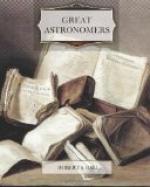In 1691, Halley became a candidate for the Savilian Professorship of Astronomy at Oxford. He was not, however, successful, for his candidature was opposed by Flamsteed, the Astronomer Royal of the time, and another was appointed. He received some consolation for this particular disappointment by the fact that, in 1696, owing to Newton’s friendly influence, he was appointed deputy Controller of the Mint at Chester, an office which he did not retain for long, as it was abolished two years later. At last, in 1703, he received what he had before vainly sought, and he was appointed to the Savilian chair.
His observations of the eclipse of the sun, which occurred in 1715, added greatly to Halley’s reputation. This phenomenon excited special attention, inasmuch as it was the first total eclipse of the sun which had been visible in London since the year 1140. Halley undertook the necessary calculations, and predicted the various circumstances with a far higher degree of precision than the official announcement. He himself observed the phenomenon from the Royal Society’s rooms, and he minutely describes the outer atmosphere of the sun, now known as the corona; without, however, offering an opinion as to whether it was a solar or a lunar appendage.
At last Halley was called to the dignified office which he of all men was most competent to fill. On February 9th, 1720, he was appointed Astronomer Royal in succession to Flamsteed. He found things at the Royal Observatory in a most unsatisfactory state. Indeed, there were no instruments, nor anything else that was movable; for such things, being the property of Flamsteed, had been removed by his widow, and though Halley attempted to purchase from that lady some of the instruments which his predecessor had employed, the unhappy personal differences which




